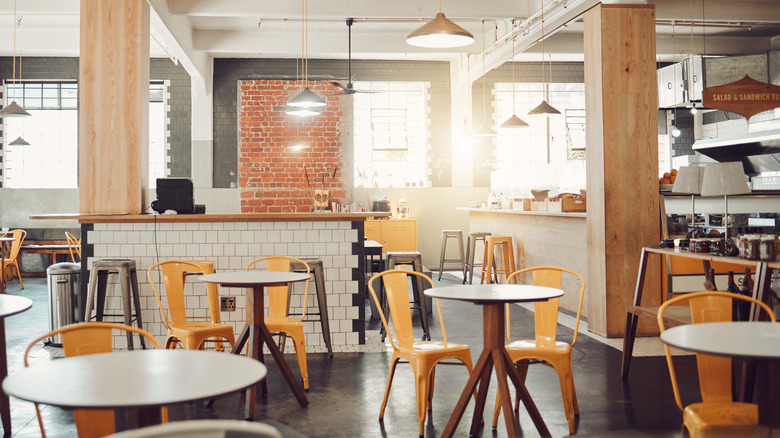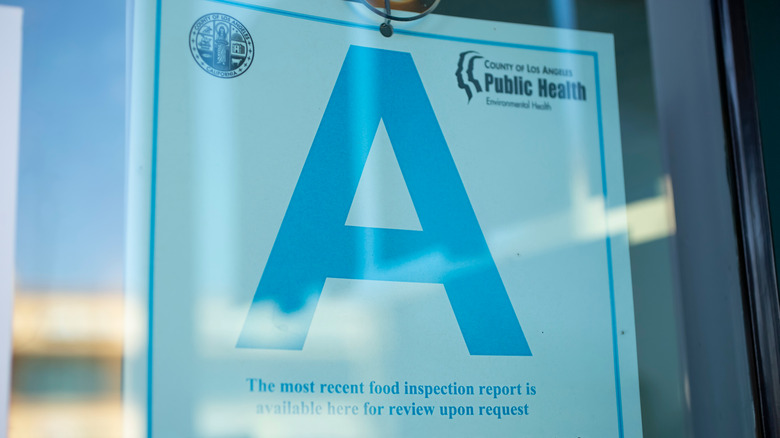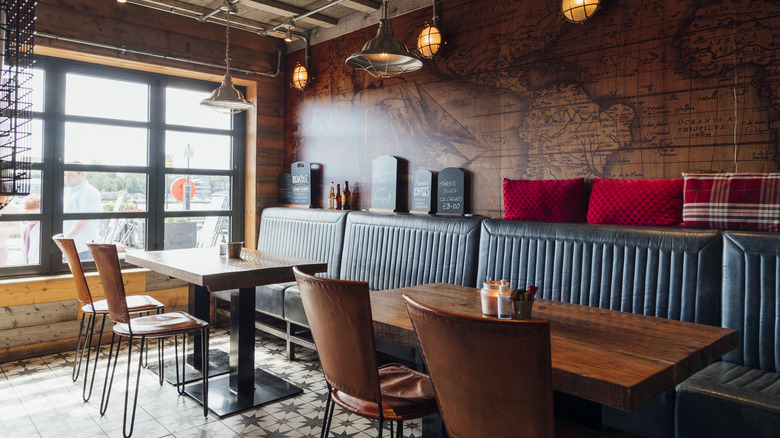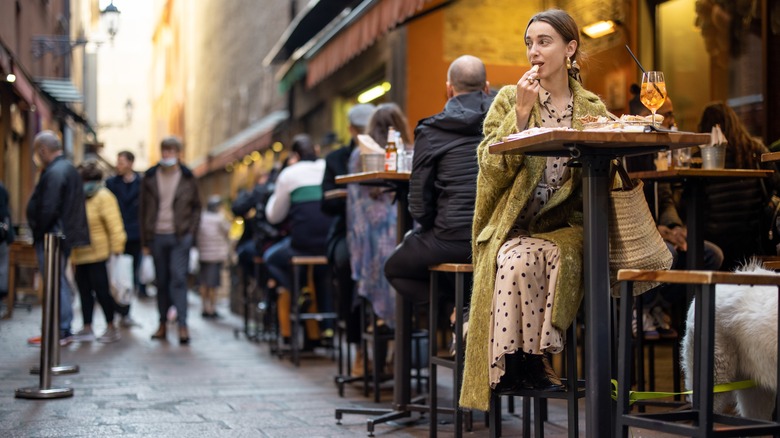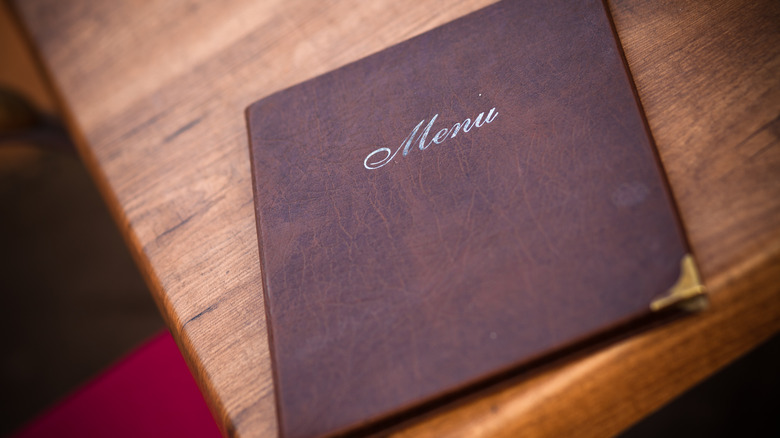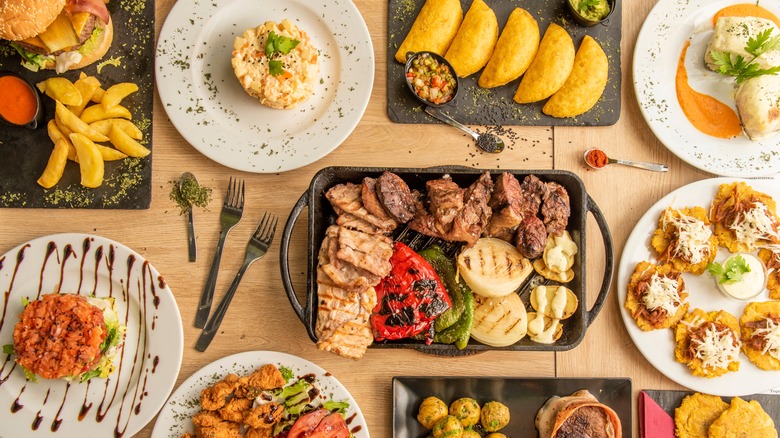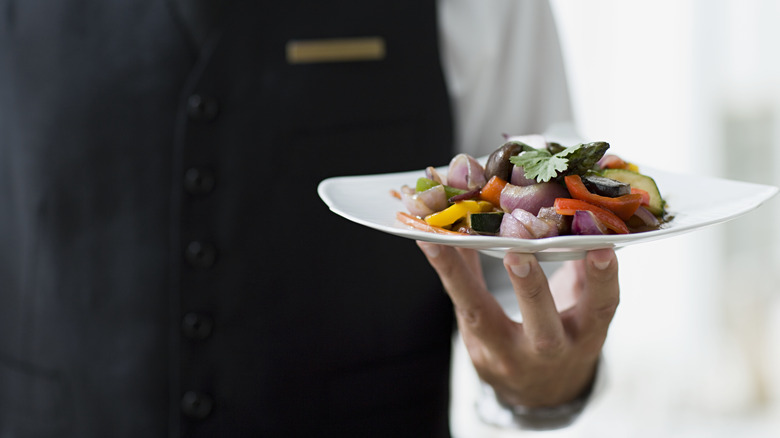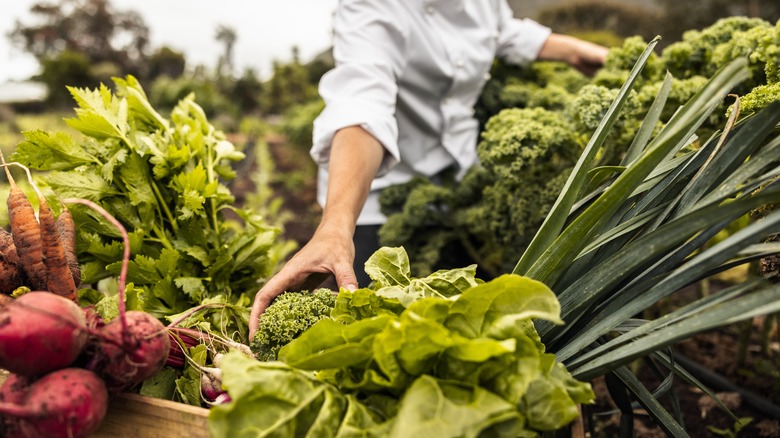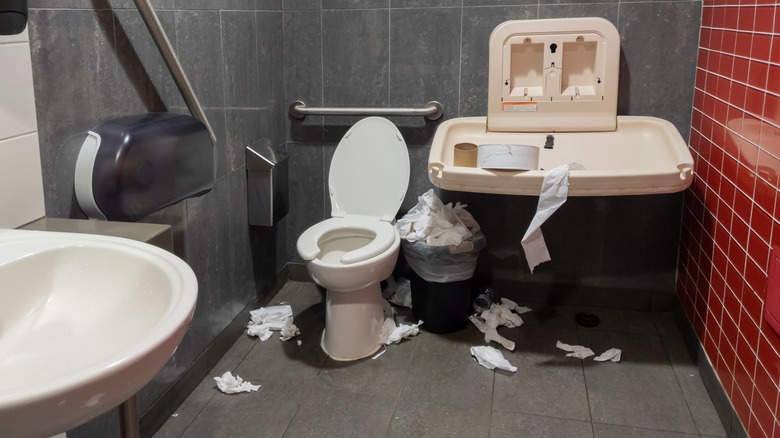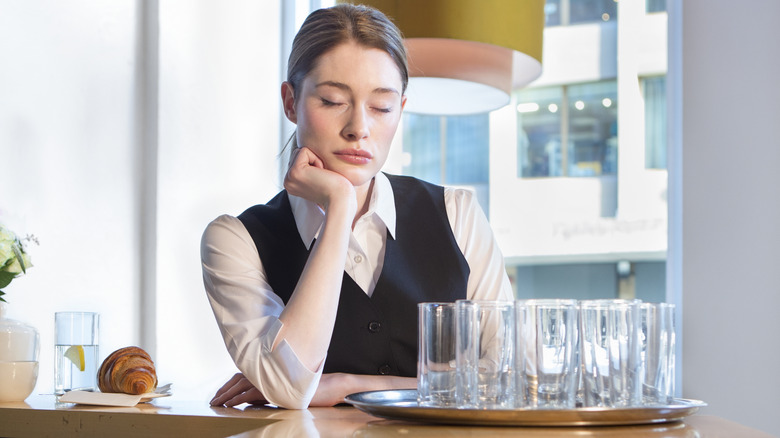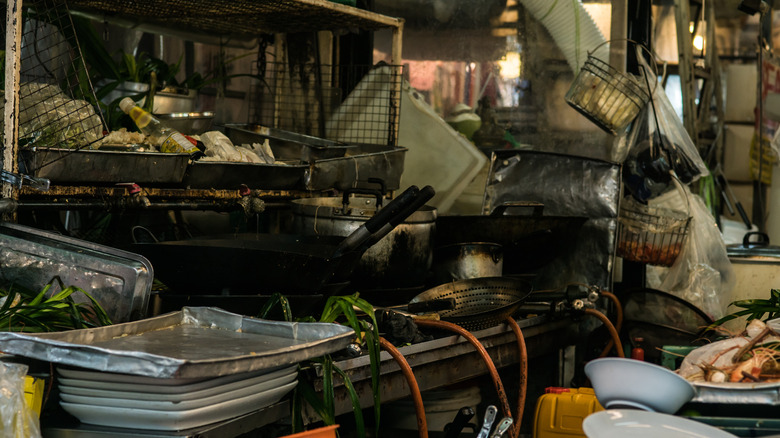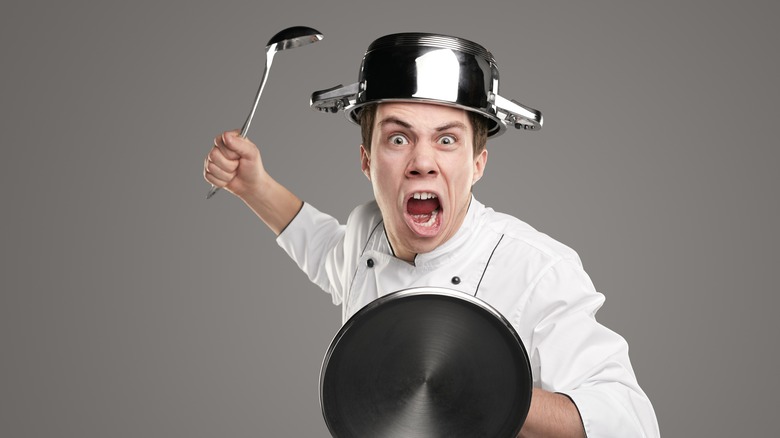16 Ways To Know A Restaurant Is Bad Before Eating There
In the age of social media it is much easier to vet and recommend a restaurant than it was years ago when word of mouth was the only superhighway. The National Restaurant Association pegged the failure rate of restaurants in the United States at approximately 30% (via foodindustry.com).
Information (in the form of reviews) can either doom your establishment or catapult it into success — though consistency here is key. Restaurants have to guard their reputations by delivering regular service and high-quality food, lest they risk succumbing to the fate of that 30% statistic.
Here are some red flags to look out for to help make your next dining experience in a new city — or even your home turf — a much more predictable and enjoyable experience.
Read reviews
Reviews are a goldmine that can help consumers make smarter decisions about where they dine. Read the good ones as well as the bad to get a broad overview of the restaurant. It gives you a valuable snapshot of general opinions. However, be wary of periodic reviews with long gaps or if social media influencers are the ones posting reviews. This could mean paid, biased critiques — let's say you read a positive review from one to two years ago and nothing in between; that's possibly a red flag.
Reading reviews also helps you anticipate what to expect at the restaurant and whether or not you want to dine there. Are you looking for seafood that is more of a Joe's Crab Shack or Le Bernardin? Thoughtful critiques of restaurants will help manage your expectations for the level of service, food, and occasion.
Roughly 61% of consumers have targeted restaurant reviews as part of their due diligence before choosing to dine at an establishment — that's more than any other type of business (per Bloom Intelligence).
Health inspector rating
Some states mandatorily have to display their health department grade outside their restaurants. Not all cities and states mandate this but Los Angeles, New York, Las Vegas, and North and South Carolina are some places that will post the A, B, and C cards at the entrance.
Health inspectors dole out these scores after their audits — some are unannounced, others are scheduled visits. Nevertheless, look for an establishment with a high health inspection rating: A. They are in place to prevent food-borne illnesses and potentially unsafe practices that protect the public's health. Think about the Jack in the Box 1992-1993 E.coli outbreak at 73 outlets where 700+ people became ill, and four children died. Best to check this rating out before dining in an establishment.
One caveat, however, is don't solely rely on the food rating. Sometimes a restaurant doesn't have hand soap in the bathroom when the inspector walks in — and that will cost the establishment points. A restaurant can also lose points if they have delivery boxes stacked in front of a sink or other critical tools. Use your sense of sight and smell (along with the posted grade) to determine if the place is bad before you eat there.
Empty restaurant
An empty restaurant during prime time is a telltale sign that you shouldn't eat there, especially if nearby restaurants are packed with diners. If the restaurant is in a busy area and you're like: "Uh, where are all the customers here?" – that's an indication it might not be a great experience. This can also mean locals aren't even going there, which is (okay, not always but still ...) a red flag that this restaurant is bad. Local foodies know where the good places are — so if you peek in and it's a ghost town, walk away.
Besides, who really wants to have an entire restaurant to themselves? Trust us, if the food was any good — especially if it's located in a vibrant part of town — it would be hopping. It's one thing to dine alone — which can be empowering — but another thing to eat in a place where you're the only customer(s).
It's a tourist trap
On the flip side of things, a place could be so jammed packed with tourists, you might want to leave it alone. Restaurants with wall-to-wall people (aka tourists) are notorious for their mediocre cuisine, high prices, minimal presentation, and aggressive front door barkers that get your attention with gimmicky signage, plastic food displays, coupons, and vouchers. Ew!
For example, if you're walking by an establishment and a greeter waves a small piece of paper in your face, keep moving! Their job is to get you to dine at the restaurant — and more often than not this tactic can be annoying and is definitely an indication the quality of the food and experience won't be worth your time or money. In general, avoid these restaurants.
Study online photos closely
It's not hard to see when food looks scrumptious versus when it's slapped together — and, well, looks ugly. Of course, some people have more of a discerning eye when it comes to culinary pictures. While a restaurant's social media images can help boost their reputation, it can also turn people off if their photos are terrible — which can be an indication the restaurant is bad.
First, visit the restaurant's website, and scroll through their offerings. Enlarge the photos to get a closer view of the dishes and how they are plated. You might pay particular attention to popular items — notice how all the components work (or don't work) with each other. Blurry, off-putting, or even oddly cropped photos is an indication they're not putting much effort on this front. We know — you're not there to eat photos, but a picture really is worth a thousand words!
Next, take a look at their social images, you'll quickly notice whether or not they have a consistent digital presence. If you spot a bunch of weird pictures of food with no likes or customer interaction, that's probably a sign to look for another restaurant.
Super long menu
Another indication of a restaurant tourist trap is when there are huge menus — we're talking 15 or more pages — often in several languages and translations. These restaurants will typically serve giant plates of food, more evidence the restaurant is bad. In places with giant menus, you can be assured that cost-cutting impacts the quality of ingredients. But legitimate restaurants never use frozen, prefab, or canned products in their dishes.
Rent is a fixed cost — and labor can be somewhat variable — but the one that has flexibility is the cost of food. And restaurants with extensive menus will use canned, frozen, or premade ingredients, which is not the hallmark of a place that delivers good eats. And so, if you walk in and ask to see a menu, and you're handed something that feels like the weight of "War and Peace," that's your cue to exit.
Lastly, a too-extensive menu shows no mastery of the cuisine it serves. After all, can you truly bring 150 options to perfection? It questions freshness due to housing such a comprehensive list of ingredients needed for each dish. Avoid these restaurants at all costs.
Cuisine confusion and themes
Sometimes restaurants try to bring together cuisine from a variety of countries. Generally, however, restaurants that are not grounded in traditional culinary technique and flavors, deliver an assortment of fanciful fusion food that isn't very good. For instance, restaurants that claim they are Japanese but serve Thai and Chinese cuisine merit a red flag. This is not to say that all fusion cuisine is bad — but do your homework.
A related spin on restaurants that attempt to marry a diverse range of cuisines is when an establishment has too many tacky themes. Think: Hollywood movie and music motifs with wait staff dressed like Marilyn Monroe or Buddy Holly — and western-themed restaurants in Pattaya, Thailand, with country music blaring and staff decked out in cowboy hats. These restaurants are meant to distract and entertain rather than tantalize your palate. Choose authenticity — your tastebuds will thank you.
Staff can't answer questions about the menu
Any good restaurant has its staff trained on the evolving menu, every dish's components, chef specials, and the more popular (and excellent) choices. Think of it like this: The server is your dining guide. And if they cannot answer basic questions about the menu, you are in for a rocky ride — and that's a sign a restaurant is bad.
Also, your server doesn't simply take your order and answer inquiries about food style and preparation. If allergies are an issue or you have specific dietary needs, they must know all the ingredients and be confident in their explanation. But if they have no idea what ingredients go into a dish — or they're cavalier about it — this is an indication the restaurant is sub-standard. And if your allergies or dietary restrictions can potentially cause life-threatening conditions, it may be best to politely walk away — or stick to something extremely safe, if possible.
Out of season product for specials
When a restaurant uses out of season ingredients it can only mean one thing: They're frozen or canned. And we're not talking about powdered porcini mushrooms for a soup or sauce base in winter. There is still no substitute for seasonal fresh ingredients — when you notice on the menu there's a lot of veggies or fruit that belong to other seasons, it's pretty clear the restaurant doesn't pride itself on the freshest items. Remember this: Seasonal = fresh = tasty.
While not all diners seek chef-driven farm-to-table menus with locally sourced ingredients, when a restaurant doesn't offer seasonal food, your experience can go downhill fast. So it's up to you to read the menu and ask lots of questions — these are ways to know if the restaurant is worth your time and money.
Restaurants that don't focus on quality, local buying, sustainability, and being more environmentally conscious are signs the food won't be as good as it could be. And that's when you head for the door.
Filthy restrooms
This may not be a factor diners think of as a total turn-off — but it should be. Because a dirty bathroom can be a sign of a messy kitchen, and, well, a messy everything else. Good management ensures that restrooms, like the kitchen, are in tip-top shape. No one wants to see layers of grime in the bathroom or especially where food is prepared. As a diner, this should be the bare minimum to expect from an establishment that serves food.
Per health inspector guidelines, restaurant bathrooms should always be stocked with toilet paper, trash bins, hot and cold water, soap, and paper towels — and as a rule of thumb, regularly sanitized top to bottom. If the trashcan is overflowing, for instance, that could be a reflection in leadership and how they operate other areas of the establishment, including the kitchen.
Neglecting simple responsibilities like this may have you questioning whether or not food is stored at proper temperatures, if it's protected against spoilage or contamination, staff hygiene, waste management, and even pest control.
And while you're scanning the bathroom, don't overlook the floors, walls, and ceilings throughout the entire place — all of these can be markers a restaurant is bad.
Disinterested staff and servers
Disinterested or disgruntled staff often indicate overall restaurant dysfunction or unhappiness with management. Food service can sometimes be an unforgiving, unappreciative, low-paid industry. But management is responsible for keeping staff morale up by creating a happy environment where each individual is taken seriously and given positive feedback, constructive criticism, and, of course, praise.
When servers are disinterested, their negative behavior can be reflected via rudeness or being impatient toward customers. Their service might also be slow and lacking precision — overall, they appear apathetic at their job and this is reflective of the attention they give you. While you don't have to expect over-the-top joy from the staff — and sometimes being understaffed can cause panic in a restaurant — patrons should always be treated with kindness and interest. So, if you notice clock-watching, bored or angry staff, and a general unhappy vibe, you might take these as clear indicators to find another restaurant.
Smelly establishments
Restaurants should have pleasant atmospheres — and that includes satisfying smells. At the very least, they shouldn't have off-putting odors. This means controlling wafting stench from the trash, stale stinky grease, pungent seafood, and foul-smelling restrooms. Whiffs like this will immediately signal to diners: "Uh, this place is gross! We're out!" Because there's really nothing worse than walking into a restaurant and getting a bad stink up your nose.
And if you're able to peek at the kitchen and you see piles of dirty dishes and a sloppy atmosphere, that's a huge problem — and it's probably where some of that odor is coming from. On the flip side, a restaurant that smells like heavy chemicals isn't worth your time or money — no one wants to sit down and smell chlorine or any type of cleaning liquid while they eat. These are all obvious messages that the restaurant (and its food) is terrible.
Uncomfortable seating
Uncomfortable seating at a restaurant may not be a sign that the food is bad — but it's not good form, nonetheless. Think of those cheap folding brown chairs with uncomfortable slats that never sit square on the ground without wobbling — or cramped tables and having to rub elbows with a stranger. This dynamic can create a negative experience. It also doesn't leave a lot of room for private conversation when the proximity to other diners is so close they can hear every word you're saying.
Often, these are not restaurants that want diners to savor their cuisine. They might be churn-and-burn operations; they want you in and they want you out. And so, if you're uncomfortable with the seating for any reason at all — and staff can't accommodate a better arrangement – know that this could be an indication your experience there won't be high quality.
Staff fighting
There are more significant issues at hand if you notice staff fighting — and it's a sign the restaurant (and its food and service) is terrible. Because your dish will be the last priority when you see or hear arguments among employees and management, don't expect the chef to care about your meal when they're distracted by theatrics and a hostile environment. It's also rude and unprofessional to "air dirty laundry" in front of customers.
Staff, in general, should present a unified front and work as a team. So, when restaurants have staff that work against each other and show signs they are angry with one another, this can cause enormous problems for the business and your food and dining experience. This toxic environment is a giant red flag. Who wants to dine in an uncomfortable and inhospitable restaurant? You should definitely walk out in a situation like this.
Poorly timed dishes
Technically, this can still be considered a red flag before you eat at a restaurant, even though you're sitting at the table and food starts to come out of the kitchen. Servers are human and can make mistakes, but if they keep bringing out the wrong dishes, or entrees get mixed up, or food doesn't get delivered, this is a sign that the restaurant service isn't up to par. It's appropriate to be patient with a server — especially if they're slamming busy — but it can be uncomfortable for everyone if food is coming out all wrong.
Staff should have a handle on this — with rare exceptions. If meals are coming out all over the map, it's a sign the restaurant isn't doing its job. Not to mention dishes will get cold while waiting for everyone to be served. This is a low bar to set for any restaurant — if they can't get this right, look elsewhere.
No one greets you at the door
This may seem like a minor infraction but it should be considered another red flag. If there isn't a maître'd or host at the entrance, a server should escort you to a table and provide you with a menu. If they don't, and you're left standing there too long, you might want to turn and leave. When a restaurant's staff lacks proper training, and you're wondering what's going on, it's not a good a sign — this gives the impression customers aren't valued. Of course, exceptions can be made, but it can also indicate the restaurant is bad.
Thoughtful human contact sets your expectations. It's also an excellent time for the host to ask if anyone in your party has special needs, such as a high chair or extra room for a wheelchair or stroller. If they don't greet you with a courteous, "Welcome in," and ask you these basic questions, know the quality of your experience will be diminished.

